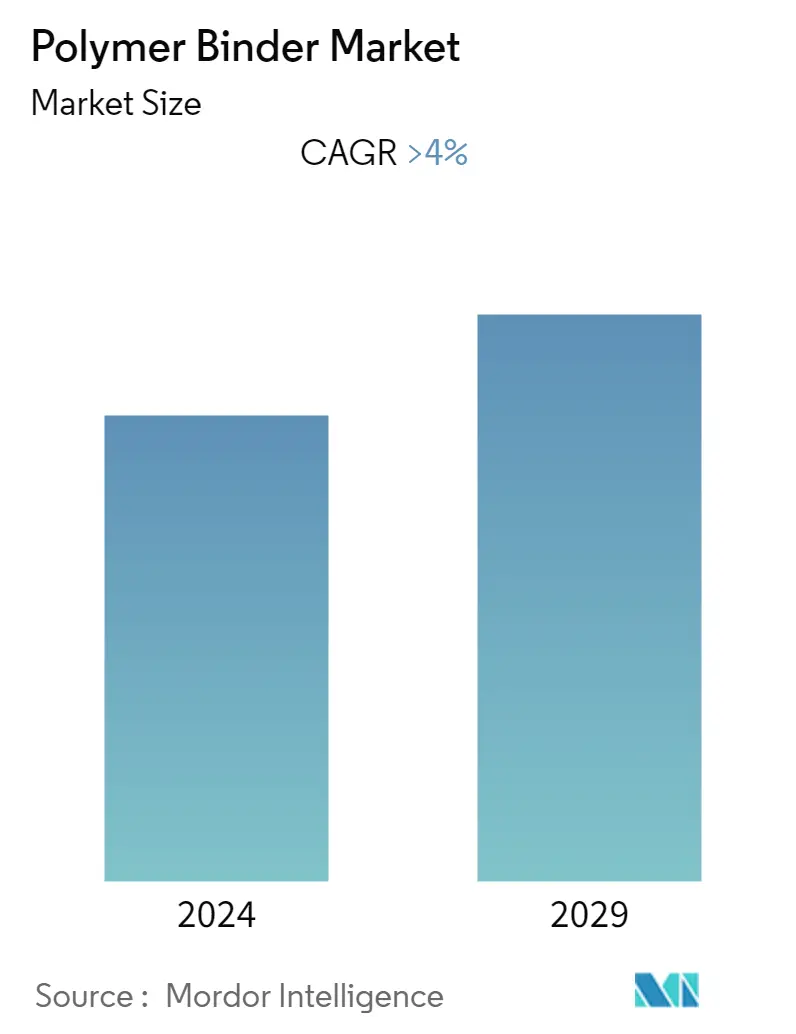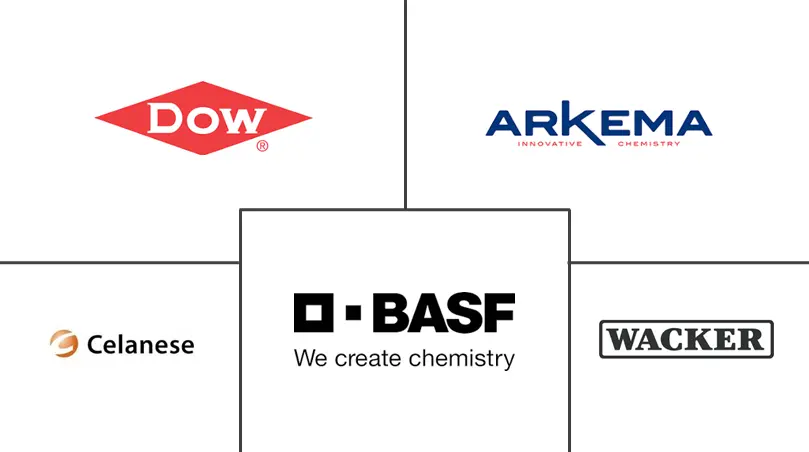Market Size of Polymer Binder Industry

| Study Period | 2019 - 2029 |
| Base Year For Estimation | 2023 |
| CAGR | > 4.00 % |
| Fastest Growing Market | Asia Pacific |
| Largest Market | Asia Pacific |
| Market Concentration | High |
Major Players
*Disclaimer: Major Players sorted in no particular order |
Polymer Binder Market Analysis
The polymer binder market is expected to register a CAGR of over 7% during the forecast period. One of the main factors driving the market is the growing demand for polymer binders from architectural coatings. However, the decreasing demand for polymer binders for use in paper and carpet products is expected to hinder the growth of the market studied.
- By application, the increasing demand for polymer binders from architectural coatings is expected to dominate the market over the forecast period.
- Growing demand for water-based polymer binders from end-user applications is likely to act as an opportunity for the market studied in the coming years.
- The Asia-Pacific region is expected to dominate the market with the largest consumption from countries, such as China and India.
Polymer Binder Industry Segmentation
The polymer binder market report includes:
| Type | |
| Vinyl Acetate | |
| Acrylic | |
| Styrene Acrylic | |
| Latex |
| Form | |
| Powder | |
| Liquid | |
| High Solids |
| Application | |
| Coatings | |
| Adhesives | |
| Textiles | |
| Inks | |
| Metals | |
| Other Applications |
| Geography | |||||||
| |||||||
| |||||||
| |||||||
| |||||||
|
Polymer Binder Market Size Summary
The polymer binder market is poised for significant growth, driven primarily by the increasing demand from architectural coatings. These binders play a crucial role in enhancing adhesion, gloss, and flexibility in coatings, making them indispensable in both exterior and interior applications within the architectural sector. The market is experiencing a shift towards water-based polymer binders, which presents new opportunities for expansion. However, the declining demand for polymer binders in paper and carpet products poses a challenge to market growth. Despite these challenges, the architectural coatings segment is expected to maintain its dominance in the market throughout the forecast period.
Regionally, the Asia-Pacific area is anticipated to lead the polymer binder market, with substantial consumption from countries like China and India. This dominance is attributed to the burgeoning construction industries in these developing nations, which are driving the demand for polymer binders in architectural applications. The region is home to some of the largest producers of polymer binders, including major companies such as BASF SE, Dow, Celanese Corporation, Arkema, and Wacker Chemie AG. Government initiatives in India to boost infrastructure and the robust development of rail and road infrastructure in China further support the market's growth prospects in the Asia-Pacific region. Despite the market's partial consolidation, these factors collectively contribute to a promising outlook for the polymer binder market during the forecast period.
Polymer Binder Market Size - Table of Contents
-
1. MARKET DYNAMICS
-
1.1 Drivers
-
1.1.1 Growing Demand for Polymer Binders from Architectural Coatings
-
1.1.2 Other Drivers
-
-
1.2 Restraints
-
1.2.1 Decreasing Demand for Polymer Binders from Paper and Carpet Products
-
1.2.2 Government Regulations on Production of Powdered Polymer Binders
-
1.2.3 Other Restraints
-
-
1.3 Industry Value Chain Analysis
-
1.4 Porter's Five Forces Analysis
-
1.4.1 Threat of New Entrants
-
1.4.2 Bargaining Power of Buyers
-
1.4.3 Bargaining Power of Suppliers
-
1.4.4 Threat of Substitute Products
-
1.4.5 Degree of Competition
-
-
-
2. MARKET SEGMENTATION
-
2.1 Type
-
2.1.1 Vinyl Acetate
-
2.1.2 Acrylic
-
2.1.3 Styrene Acrylic
-
2.1.4 Latex
-
-
2.2 Form
-
2.2.1 Powder
-
2.2.2 Liquid
-
2.2.3 High Solids
-
-
2.3 Application
-
2.3.1 Coatings
-
2.3.2 Adhesives
-
2.3.3 Textiles
-
2.3.4 Inks
-
2.3.5 Metals
-
2.3.6 Other Applications
-
-
2.4 Geography
-
2.4.1 Asia-Pacific
-
2.4.1.1 China
-
2.4.1.2 India
-
2.4.1.3 Japan
-
2.4.1.4 South Korea
-
2.4.1.5 Rest of Asia-Pacific
-
-
2.4.2 North America
-
2.4.2.1 United States
-
2.4.2.2 Canada
-
2.4.2.3 Mexico
-
-
2.4.3 Europe
-
2.4.3.1 Germany
-
2.4.3.2 United Kingdom
-
2.4.3.3 France
-
2.4.3.4 Italy
-
2.4.3.5 Rest of Europe
-
-
2.4.4 South America
-
2.4.4.1 Brazil
-
2.4.4.2 Argentina
-
2.4.4.3 Rest of South America
-
-
2.4.5 Middle-East and Africa
-
2.4.5.1 Saudi Arabia
-
2.4.5.2 South Africa
-
2.4.5.3 Rest of Middle-East and Africa
-
-
-
Polymer Binder Market Size FAQs
What is the current Polymer Binder Market size?
The Polymer Binder Market is projected to register a CAGR of greater than 4% during the forecast period (2024-2029)
Who are the key players in Polymer Binder Market?
BASF SE, Dow, Celanese Corporation, Arkema and Wacker Chemie AG are the major companies operating in the Polymer Binder Market.

